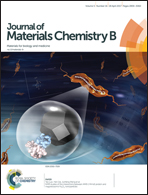Optimization of pegylated iron oxide nanoplatforms for antibody coupling and bio-targeting†
Abstract
PEGylation has been established as a valuable strategy to minimize nanoparticle clearance by the reticulo-endothelial system due to hydrophilicity and steric repulsion of PEG chains. In this study we functionalized superparamagnetic iron oxide nanoparticle surface with two PEG differing in their length (n = 23 and 44) and terminal functionality, COOH and CH3. By varying the ratio of the two different PEG, we optimized the molecular architecture of the nanoplatform to obtain maximum stability and low toxicity under physiological conditions. The best nanoplatform was evaluated as MRI contrast for mouse brain vascularization imaging at 7 T. The carboxylic acid functions of the nanoplatform were used to covalently bind an antibody, Ab. This antibody, labeled with a fluorophore, targets the ETA receptor, a G-protein-coupled receptor involved in the endothelin axis and overexpressed in various solid tumours, including ovarian, prostate, colon, breast, bladder and lung cancers. In vitro studies, performed by flow cytometry and magnetic quantification, showed the targeting efficiency of the Ab-nanoplatforms. Clearly, an imaging tracer for cancer diagnosis from a bimodal contrast agent (fluorescence and MRI) was thus obtained.



 Please wait while we load your content...
Please wait while we load your content...